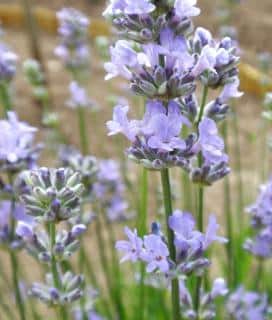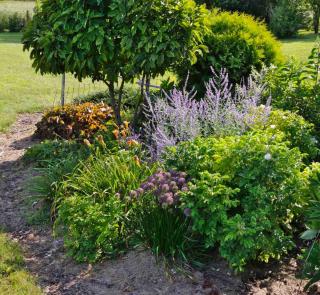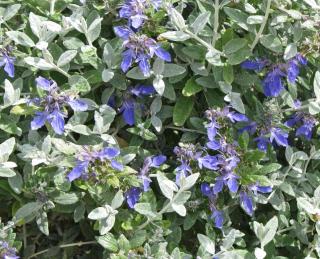

Wow, imagine getting that ocean-blue Caribbean feel right in your own back yard! There are a lot of silver-blue shrubs, each more outstanding than the next, bearing flowers in different seasons of the year. Their small blue flowers vary in intensity, giving your landscaping a natural feel that pairs just as well with perennial beds as it does with shrubs. These do great in dry gardens!
Lavender pairs well with everything, as long as it grows in full sun with very well-draining soil. It’ll be perfectly happy in poor soil, even it’s little more than a heap of gravel (even limestone!). What does it not like? Heavy, soggy soil.
The blooming begins in May and can keep on going until September-October if you combine different varieties. Lavender flowers arch up, higher than the rounded mound of the shrub itself. The fabulous, heady scent it releases attracts a great many pollinating insects, from bees to butterflies.
Medicinal lavender, Lavandula angustifolia, gave rise to lavandin from which essential oil is extracted. Many ornamental cultivars also arose from this English lavender:
 ‘Grosso’, farmed for its oils, and ‘Munstead’ both have intense blue colors,
‘Grosso’, farmed for its oils, and ‘Munstead’ both have intense blue colors,Lavender pairs very well with grasses, perennials, lily bulbs and ancient rose varieties. The pale blue colors of its flowers usually responds well to bright colors, yellow in particular. The silver-gray leaves stay as remarkable as ever in winter, especially with a few Phormium or grasses interspersed among the clumps. When aligned along a hillside, the illusion of vast fields of lavender also creates a magnificent landscape.
The elegant Perovskia atriplicifolia bears a cloud of purple flower scapes, fine and ethereal, from July to September. These tower at nearly 4 feet tall (1.20 m). Narrow, silver-green leaves are 2 – 3 inches long (5-8 cm). They release a delicious sage-like fragrance, but they aren’t edible. Young stems are covered with white fuzz which disappears as they age.
 Perovskia ‘Blue Spire’ has vibrant, very intense blue colors.
Perovskia ‘Blue Spire’ has vibrant, very intense blue colors.Cut the clump back to 8 inches (20 cm) from the ground in spring. Make the most of the end of summer: collect and prepare cuttings that you winterize under a cold frame. Young plants are rather vulnerable to the cold, so it’s recommended to plant in spring. Select a location that’s in full sun and that doesn’t get too wet in winter.
Perovskia loves dry soil and, in particular, seaside terrain. It’ll excel in a care-free flower bed together with other drought-resistant plants such as silver ragwort (Senecio cineraria), artemisia (Artemisia), oceanblue morning glory (Convolvulus mauritanicus), the curry plant (Helichrysum italicum), thistles, dusty miller… Its tall, slender bearing also pairs well with landscaping rose trees such as EMERA® ‘Noatraum’.
 The elegant Teucrium fruticans is a typically Mediterranean shrub with evergreen, fuzz-covered fragrant leaves that are a beautiful silvery-gray color. Its advantage is that it bears a profusion of small, lavender-blue flowers as early as January. The blooming just keeps on coming all the way to June, and even gives a last burst in Fall. Flowers are similar to those of sage, with a slightly oversized underlip. They’re set up in long panicles that you can cut back after they’ve wilted: this triggers new growth.
The elegant Teucrium fruticans is a typically Mediterranean shrub with evergreen, fuzz-covered fragrant leaves that are a beautiful silvery-gray color. Its advantage is that it bears a profusion of small, lavender-blue flowers as early as January. The blooming just keeps on coming all the way to June, and even gives a last burst in Fall. Flowers are similar to those of sage, with a slightly oversized underlip. They’re set up in long panicles that you can cut back after they’ve wilted: this triggers new growth.
Teucrium is typically grown in 3-4 foot hedges (1 or 1.5m), but it also works well for topiary. The repeated pruning of its branches together with the delicate, fine texture of its foliage means it fills into lush, dense growth that is easily shaped. It also deserves a spot in coastal gardens. Cut it back short after it blooms.